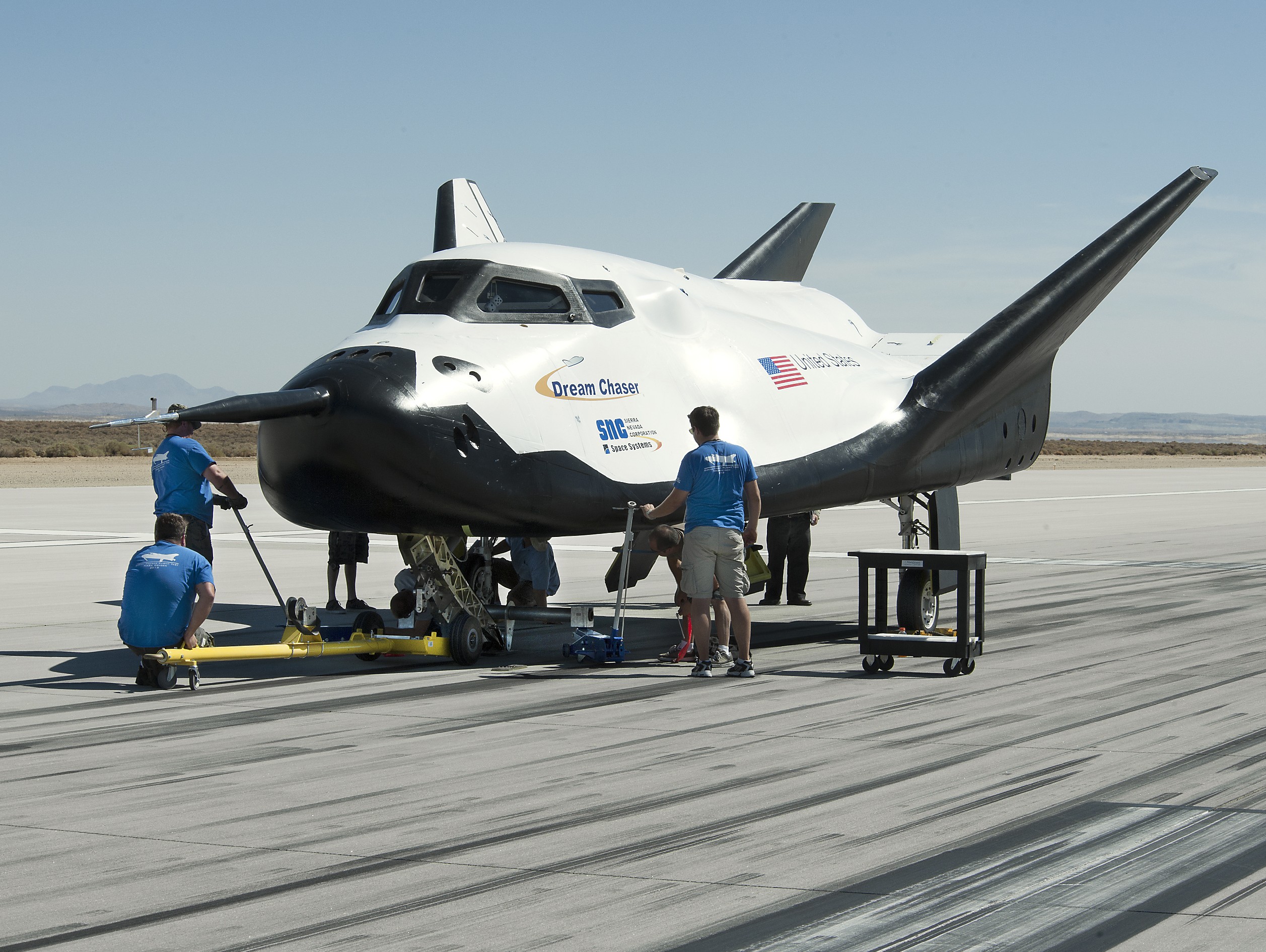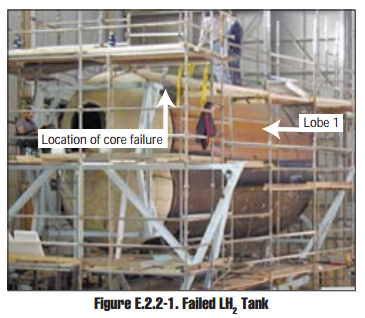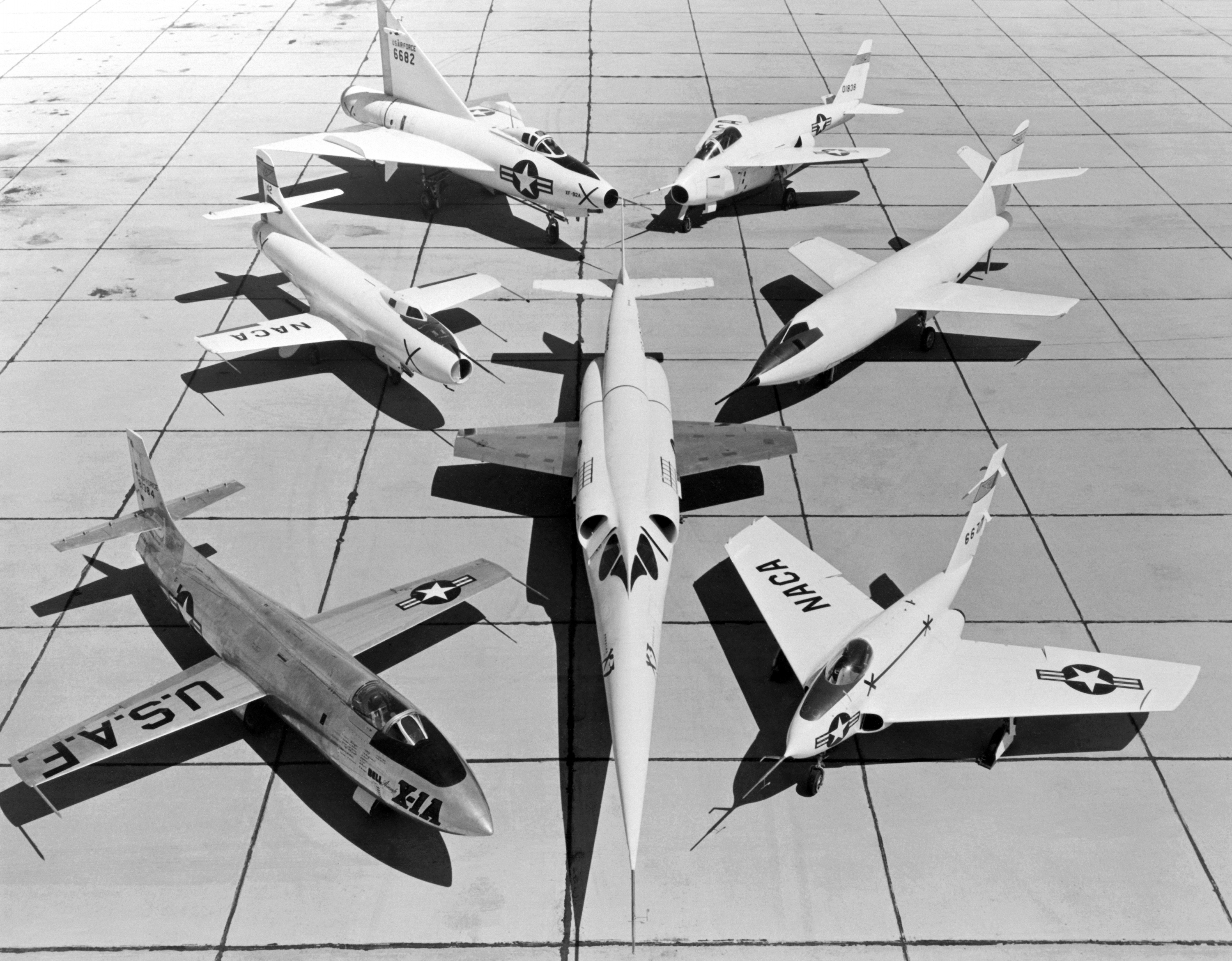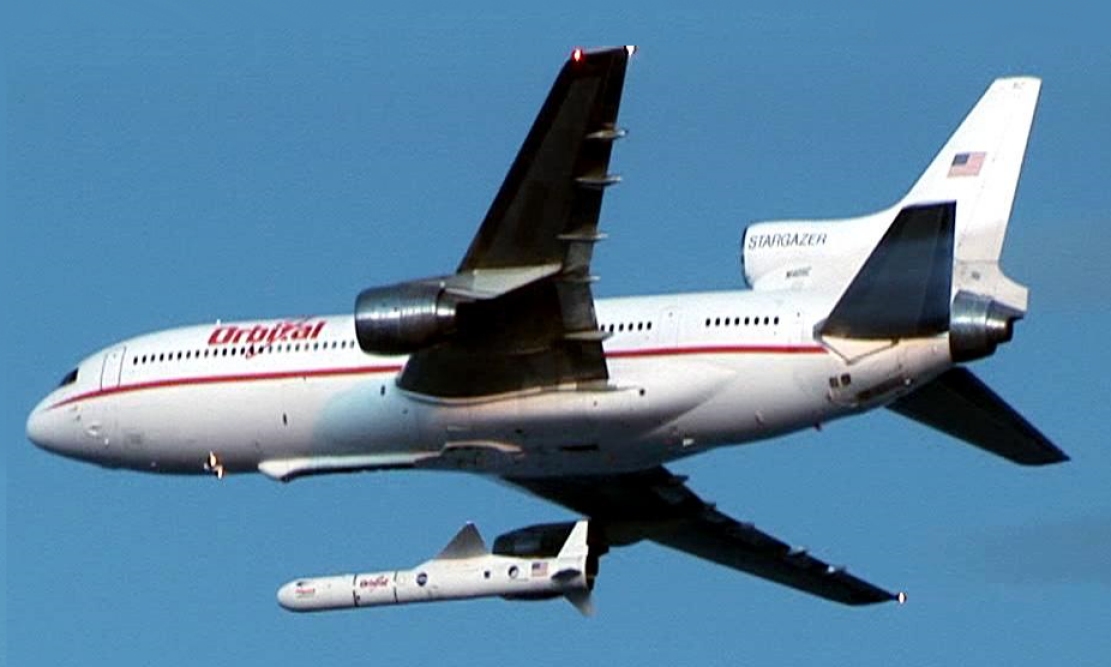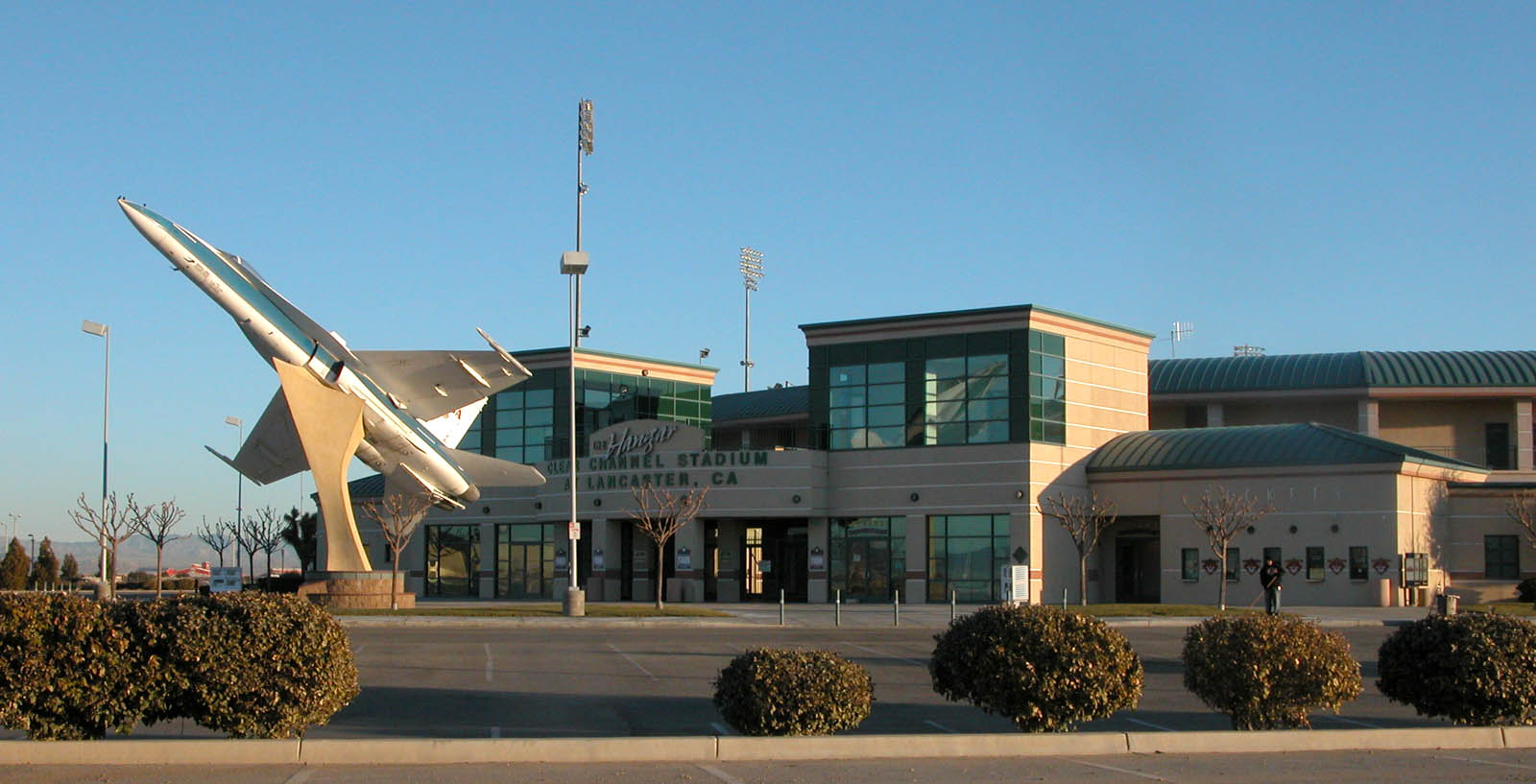|
Orbital Sciences X-34
The Orbital Sciences X-34 was intended to be a low-cost testbed for demonstrating "key technologies" that could be integrated into the Reusable Launch Vehicle program. It was intended to be an autonomous pilotless craft powered by a " Fastrac" liquid-propellant rocket engine, capable of reaching Mach 8 and performing 25 test flights per year. The X-34 began as a program for a suborbital reusable-rocket technology demonstrator. In early 2001, the first flight vehicle was near completion, but the program was ended due to budget concerns. Up to this point, the project had encompassed spending of just under $112 million: $85.7M from the original contract with designer Orbital Sciences, $16M from NASA and various government agencies for testing, and an additional $10M for Orbital Sciences to adapt its L-1011 carrier aircraft to accommodate the X-34. The program was officially canceled by NASA on March 31, 2001. The unpowered prototype had been used only for towing and captive fli ... [...More Info...] [...Related Items...] OR: [Wikipedia] [Google] [Baidu] |
Spaceplane
A spaceplane is a vehicle that can flight, fly and gliding flight, glide as an aircraft in Earth's atmosphere and function as a spacecraft in outer space. To do so, spaceplanes must incorporate features of both aircraft and spacecraft. Orbital spaceflight, Orbital spaceplanes tend to be more similar to conventional spacecraft, while sub-orbital spaceplanes tend to be more similar to fixed-wing aircraft. All spaceplanes as of 2024 have been rocket engine, rocket-powered for takeoff and climb, but have then landed as unpowered glider (aircraft), gliders. Four examples of spaceplanes have successfully launched to orbit, Atmospheric entry, reentered Earth's atmosphere, and Landing#Aircraft, landed: the U.S. Space Shuttle, Russian Buran (spacecraft), Buran, U.S. Boeing X-37, X-37, and the Chinese Shenlong (spacecraft), Shenlong. Another, Dream Chaser, is under development in the U.S. As of 2024 all past and current orbital spaceplanes VTHL, launch vertically; some are carried as ... [...More Info...] [...Related Items...] OR: [Wikipedia] [Google] [Baidu] |
Suborbital
A sub-orbital spaceflight is a spaceflight in which the spacecraft reaches outer space, but its trajectory intersects the surface of the gravitating body from which it was launched. Hence, it will not complete one orbital revolution, will not become an artificial satellite nor will it reach escape velocity. For example, the path of an object launched from Earth that reaches the Kármán line (about – above sea level), and then falls back to Earth, is considered a sub-orbital spaceflight. Some sub-orbital flights have been undertaken to test spacecraft and launch vehicles later intended for orbital spaceflight. Other vehicles are specifically designed only for sub-orbital flight; examples include crewed vehicles, such as the X-15 and SpaceShipTwo, and uncrewed ones, such as ICBMs and sounding rockets. Flights which attain sufficient velocity to go into low Earth orbit, and then de-orbit before completing their first full orbit, are not considered sub-orbital. Examples o ... [...More Info...] [...Related Items...] OR: [Wikipedia] [Google] [Baidu] |
Spaceplanes
A spaceplane is a vehicle that can fly and glide as an aircraft in Earth's atmosphere and function as a spacecraft in outer space. To do so, spaceplanes must incorporate features of both aircraft and spacecraft. Orbital spaceplanes tend to be more similar to conventional spacecraft, while sub-orbital spaceplanes tend to be more similar to fixed-wing aircraft. All spaceplanes as of 2024 have been rocket-powered for takeoff and climb, but have then landed as unpowered gliders. Four examples of spaceplanes have successfully launched to orbit, reentered Earth's atmosphere, and landed: the U.S. Space Shuttle, Russian Buran, U.S. X-37, and the Chinese Shenlong. Another, Dream Chaser, is under development in the U.S. As of 2024 all past and current orbital spaceplanes launch vertically; some are carried as a payload in a conventional fairing, while the Space Shuttle used its own engines with the assistance of boosters and an external tank. Orbital spaceflight takes place ... [...More Info...] [...Related Items...] OR: [Wikipedia] [Google] [Baidu] |
Sierra Nevada Dream Chaser
Dream Chaser is an American reusable lifting-body spaceplane developed by Sierra Space. Originally intended as a crewed vehicle, the Dream Chaser Space System is set to be produced after the Dream Chaser Cargo System cargo variant is operational. The crewed variant is planned to carry up to seven people and cargo to and from low Earth orbit. Sierra plans to manufacture a fleet of the spaceplane. The Dream Chaser was originally started in 2004 as a project of SpaceDev, a company that was later acquired by the Sierra Nevada Corporation (SNC) in 2008. In April 2021 the project was taken over by the Sierra Space Corporation (SSC), spun off from the Sierra Nevada Corporation as its own fully independent company. The cargo Dream Chaser is designed to resupply the International Space Station with both pressurized and unpressurized cargo. It is intended to be launched vertically on the Vulcan Centaur rocket and autonomously land horizontally on conventional runways. A proposed ve ... [...More Info...] [...Related Items...] OR: [Wikipedia] [Google] [Baidu] |
Prometheus (spacecraft)
Prometheus was a proposed crewed vertical-takeoff, horizontal-landing (VTHL) lifting body spaceplane concept put forward by Orbital Sciences Corporation in late 2010 as part of the second phase of NASA's Commercial Crew Development (CCDev) program. Design The Prometheus design was based on an earlier NASA design, the HL-20 Personnel Launch System. Prometheus also included other NASA-funded design improvements to HL-20 by Orbital Sciences that were done some years ago as part of NASA's Orbital Space Plane program. Whereas the HL-20 was a pure lifting body, the Prometheus design was for a Blended Lifting Body (BLB). This design combines volumetric efficiency with superior aerodynamic qualities. Prometheus could have initially carried four astronauts to the International Space Station or future commercial space stations but further development could have increased the seating capacity to six. The baselined launch vehicle was the Atlas V, but the design could have accommodated ... [...More Info...] [...Related Items...] OR: [Wikipedia] [Google] [Baidu] |
Lockheed Martin X-33
The Lockheed Martin X-33 was a proposed uncrewed, sub-scale technology demonstrator suborbital spaceplane that was developed for a period in the 1990s. The X-33 was a technology demonstrator for the VentureStar orbital spaceplane, which was planned to be a next-generation, commercially operated reusable launch vehicle. The X-33 would flight-test a range of technologies that NASA believed it needed for single-stage-to-orbit reusable launch vehicles (SSTO RLVs), such as metallic thermal protection systems, composite cryogenic fuel tanks for liquid hydrogen, the aerospike engine, autonomous (uncrewed) flight control, rapid flight turn-around times through streamlined operations, and its lifting body aerodynamics. Failures of its 21-meter wingspan and multi-lobed, composite-material fuel tank during pressure testing ultimately led to the withdrawal of federal support for the program in early 2001. Lockheed Martin has conducted unrelated testing, and has had a single success after ... [...More Info...] [...Related Items...] OR: [Wikipedia] [Google] [Baidu] |
Cygnus (spacecraft)
Cygnus is an Expendable launch system, expendable American Uncrewed spacecraft, automated cargo spacecraft designed for International Space Station (ISS) resupply missions. It was initially developed by Orbital Sciences Corporation with financial support from NASA under the Commercial Orbital Transportation Services (COTS) program. To create Cygnus, Orbital paired a pressurized cargo module, largely based on the Multi-Purpose Logistics Module, built by Thales Alenia Space and previously used by the Space Shuttle for ISS resupply, with a service module based on Orbital's GEOStar, a satellite bus. After a successful demonstration flight in 2013, Orbital was chosen to receive a Commercial Resupply Services (CRS) contract. A larger Enhanced Cygnus was introduced in 2015. Orbital Sciences merged into Orbital ATK in 2015; Northrop Grumman purchased Orbital ATK in 2018 and has continued to operate Cygnus missions. A further enlarged Mission B Cygnus is expected to be introduced in 2025. ... [...More Info...] [...Related Items...] OR: [Wikipedia] [Google] [Baidu] |
List Of Experimental Aircraft
As used here, an experimental or research and development aircraft, sometimes also called an X-plane, is one which is designed or substantially adapted to investigate novel flight technologies. Argentina * FMA I.Ae. 37, FMA I.Ae. 37 glider – testbed for production fighter Australia * GAF Pika – manned test craft for drone program Brazil * Baumgartl PB-60 – towed experimental rotor kite Canada *AEA Silver Dart (1909) – First aircraft to fly in Canada *Avrocar, Avro Canada Avrocar – Ducted fan VTOL *Birdman Project 102 – *Canadair CL-52 – jet engine testbed (converted Boeing B-47) *Canadair CL-84 Dynavert – tilt-wing VTOL *de Havilland Canada DHC-5 Buffalo, de Havilland Canada C-8A – Quiet Short-Haul Research Aircraft *de Havilland Canada DHC-5 Buffalo, de Havilland Canada C-8A – Air-Cushion Landing System *de Havilland Canada DHC-5 Buffalo, de Havilland Canada C-8A – Augmentor Wing *Marsden Gemini – variable-geometry glider *NRC tailless glider – tai ... [...More Info...] [...Related Items...] OR: [Wikipedia] [Google] [Baidu] |
Stargazer (aircraft)
''Stargazer'' is a Lockheed L-1011 TriStar built in 1974, that was modified in 1994 for use by Orbital Sciences (now part of Northrop Grumman) as a mother ship for the Pegasus (rocket), Pegasus, a small-lift launch vehicle. , 45 rockets (containing nearly 100 satellites) have been launched from ''Stargazer''. ''Stargazer'' is the only L-1011 airframe still airworthy. History The first Pegasus launch to use Stargazer was conducted on June 27, 1994, as the maiden flight of the Pegasus-XL. Previous launches used the NASA-operated Boeing B-52 Stratofortress, B-52 nicknamed "Balls 8," which was also used for four subsequent launches, as the original Pegasus could not be launched from Stargazer due to clearance issues. A modified version, the Pegasus-H, was introduced to rectify this. Stargazer was also used for captive tests and transportation of the Orbital Sciences X-34, X-34 hypersonic research aircraft; however, the drop tests used Balls 8. Pegasus launches using Stargazer ar ... [...More Info...] [...Related Items...] OR: [Wikipedia] [Google] [Baidu] |
Dryden Research Center
The NASA Neil A. Armstrong Flight Research Center (AFRC) is an aeronautical research center operated by NASA. Its primary campus is located inside Edwards Air Force Base in California and is considered NASA's premier site for aeronautical research. AFRC operates some of the most advanced aircraft in the world and is known for many aviation firsts, including supporting the first crewed airplane to exceed the speed of sound in level flight (Bell X-1), highest speed by a crewed, powered aircraft (North American X-15), the first pure digital fly-by-wire aircraft (F-8 DFBW), and many others. AFRC operated a second site next to Air Force Plant 42 in Palmdale, California, known as Building 703, once the former Rockwell International/North American Aviation production facility. There, AFRC housed and operated several of NASA's Science Mission Directorate aircraft including SOFIA (Stratospheric Observatory For Infrared Astronomy), a DC-8 Flying Laboratory, a Gulfstream C-20A UAVSAR and ... [...More Info...] [...Related Items...] OR: [Wikipedia] [Google] [Baidu] |
Lancaster, California
Lancaster is a charter city in northern Los Angeles County, California, Los Angeles County, in the Antelope Valley of the western Mojave Desert in Southern California, United States. As of the 2020 United States census, 2020 census, the population was 173,516, making Lancaster the List of United States cities by population, 158th-most populous city in the United States and the List of largest cities in California by population, 30th most populous in California. Lancaster is a twin cities, twin city with its southern neighbor Palmdale, California, Palmdale; together, they are the principal cities within the Antelope Valley region. Lancaster is located approximately north (via Interstate 5 in California, I-5 and California State Route 14, SR 14) of downtown Los Angeles and is near the Kern County, California, Kern County line. It is separated from the Los Angeles Basin by the San Gabriel Mountains to the south and from Bakersfield, California, Bakersfield and the San Joaquin Va ... [...More Info...] [...Related Items...] OR: [Wikipedia] [Google] [Baidu] |
Mojave, California
Mojave (formerly Mohave) is an unincorporated community in Kern County, California, United States. Mojave is located east of Bakersfield, and north of Los Angeles, at an elevation of . The town is located in the western region of the Mojave Desert, below and east of Oak Creek Pass and the Tehachapi Mountains. Mojave is on the Pacific Crest Trail. The population was 4,238 at the 2010 census, up from 3,836 at the 2000 census. Telephone numbers in Mojave follow the format (661) 824-xxxx and the area includes three postal ZIP Codes. History The town of Mojave began in 1876 as a construction camp on the Southern Pacific Railroad. From 1884 to 1889, the town was the western terminus of the , twenty-mule team at Harmony Borax Works in Death Valley. It later served as headquarters for construction of the Los Angeles Aqueduct. Mojave Airport: aviation and military use Located near Edwards Air Force Base, Naval Air Weapons Station China Lake, and Palmdale Regional Airport, Mo ... [...More Info...] [...Related Items...] OR: [Wikipedia] [Google] [Baidu] |



